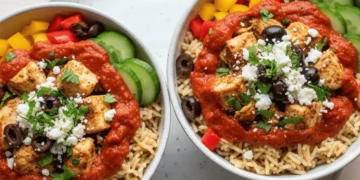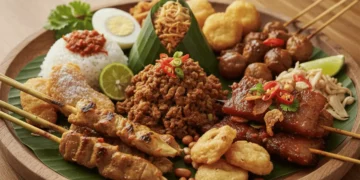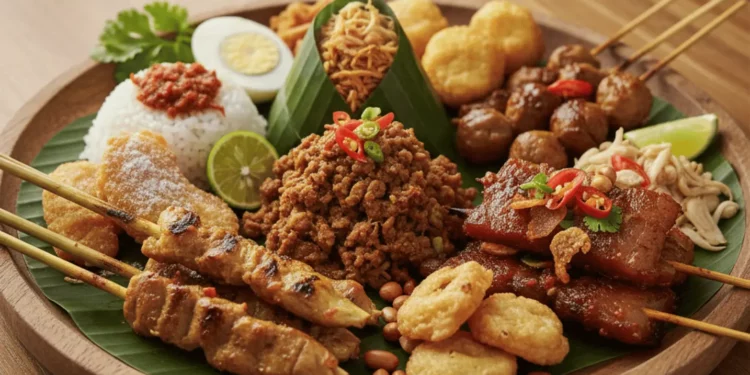Discover the vibrant heart of Balinese culture through its incredible street food. From savory grilled skewers to sweet, colorful cakes, the island’s bustling markets and roadside stalls, known as warungs, offer a delicious adventure. This is where you’ll find the most authentic and flavorful local cuisine.
4 Reasons to Love Balinese Street Food
Exploring the street food of Bali is an essential part of any visit. It’s an immersive experience that offers more than just a meal; it’s a direct connection to the island’s culture, people, and culinary traditions. Here are four fantastic reasons why you need to dive into Bali’s street food scene.
An Explosion of Authentic Flavors
Balinese street food is renowned for its complex and bold flavors. Unlike restaurant food that might be toned down for tourists, street food offers the authentic, undiluted taste of the island. The secret lies in the use of a traditional spice paste called Basa Gede, a blend of numerous ingredients like galangal, turmeric, chili, and shrimp paste. This base creates a depth of flavor that is savory, spicy, sweet, and aromatic all at once. From the smoky char of grilled sate to the rich coconut curry of a Nasi Campur, your taste buds are in for an unforgettable journey.
It’s Incredibly Affordable
One of the greatest appeals of Balinese street food is its value. You can enjoy a full, satisfying meal for a fraction of the cost of dining in a restaurant. This affordability allows you to sample a wide variety of dishes without breaking the bank. For just a few dollars, you can try several different items, from savory snacks to sweet desserts. This makes it the perfect way to eat for budget-conscious travelers and anyone who wants to experience more of what the local cuisine has to offer.
A Glimpse into Local Life
Eating at a street food stall or a local warung offers a window into the daily life of the Balinese people. You’ll eat alongside locals, watch vendors skillfully prepare dishes that have been passed down through generations, and soak in the vibrant atmosphere of a bustling market. It’s a far more personal and engaging experience than sitting in a tourist-focused restaurant. You’re not just a customer; you’re a participant in a daily cultural ritual.
Unbeatable Variety and Freshness
The sheer variety of street food in Bali is astounding. In the morning, you’ll find vendors selling sweet rice cakes and porridge for breakfast. By lunchtime, the air is filled with the aroma of grilled meats and bubbling soups. In the evening, night markets come alive with countless options. The ingredients are almost always fresh, sourced from local markets that same day. This commitment to freshness is a core principle of Balinese cooking, similar to the emphasis on quality ingredients taught in professional baking schools. Whether you’re craving something savory, spicy, or sweet, there is a street food dish waiting for you.
Core Ingredients in Balinese Street Food
Balinese cuisine is built on a foundation of fresh, aromatic ingredients that create its distinctive taste. While each dish is unique, you will find these core components used across a wide range of street food offerings. Understanding them is key to appreciating the local food culture.
The Foundation: Rice and Spices
| Ingredient | Description | Role in Cooking |
|---|---|---|
| Rice (Nasi) | The staple food of Indonesia. You’ll find it steamed, fried, or compressed into cakes (lontong). | Forms the base of most meals, like Nasi Goreng (fried rice) and Nasi Campur (mixed rice). |
| Basa Gede | The quintessential Balinese spice paste. A complex blend of shallots, garlic, galangal, turmeric, ginger, chili peppers, and more. | This is the flavor backbone of countless dishes, used as a marinade, a stir-fry base, or a seasoning. |
| Chili (Sambal) | A spicy condiment made from crushed chili peppers, often mixed with shrimp paste, lime juice, and other seasonings. | Served with almost every meal to add a kick of heat. There are dozens of regional varieties. |
| Coconut | Used in many forms: coconut milk for curries, grated coconut for salads and desserts, and coconut oil for frying. | Adds richness, creaminess, and a subtle sweetness to both savory and sweet dishes. |
Key Proteins and Vegetables
- Chicken (Ayam) and Pork (Babi): These are the most common proteins. You’ll find them grilled, fried, or stewed in rich sauces.
- Seafood (Ikan): Especially popular in coastal areas, fish is often grilled whole over coconut husks.
- Tofu and Tempeh: Fermented soybean products that are excellent sources of protein and are featured in many vegetarian dishes. They are a staple, much like foundational ingredients used in vegan baking.
- Long Beans, Spinach, and Bean Sprouts: These vegetables are frequently used in salads (urap) or as part of a mixed rice plate.
Iconic Balinese Street Foods You Need to Try
Navigating the world of Balinese street food can be an exciting adventure. To get you started, here are some of the most popular and delicious dishes you absolutely must try.
Sate Lilit (Minced Meat Satay)
Unlike the chunk-of-meat skewers you might be used to, Sate Lilit is a uniquely Balinese creation.
- What It Is: Minced meat (often chicken, pork, or fish) is blended with grated coconut and rich Basa Gede spice paste. This mixture is then “wrapped” or lilit around a skewer, which can be a traditional bamboo stick or a flattened stalk of lemongrass for extra aroma.
- Why It’s Special: The use of minced meat makes the sate incredibly tender and moist. Grilling over charcoal gives it a smoky flavor that, combined with the fragrant lemongrass, is simply irresistible. It’s often served with a fiery sambal matah (raw shallot and lemongrass sambal).
Babi Guling (Suckling Pig)
Babi Guling is one of Bali’s most celebrated dishes, a true feast for the senses.
- What It Is: A whole pig is stuffed and marinated with a rich blend of Balinese spices, including turmeric, galangal, and chili. It is then slowly roasted over a fire for hours until the skin is perfectly crispy and the meat is fall-off-the-bone tender.
- Why It’s Special: While you can find it in restaurants, the best Babi Guling often comes from roadside warungs that specialize in this one dish. A serving typically includes slices of tender meat, a piece of crunchy crackling skin, blood sausage, and vegetables, all served over steamed rice.
Nasi Jinggo (Miniature Rice Packets)
Nasi Jinggo is the ultimate Balinese fast food—a quick, cheap, and surprisingly satisfying meal.
- What It Is: A small, fist-sized portion of steamed rice is served with a variety of side dishes and wrapped in a banana leaf. The accompaniments typically include shredded chicken or beef, fried tempeh, vegetables, and a very spicy sambal.
- Why It’s Special: Its small portion size and incredibly low price make it the perfect snack or light meal. The banana leaf wrapper imparts a subtle, earthy aroma to the rice. You’ll see these little packets sold everywhere, especially at night.
Jaje Bali (Balinese Sweets and Cakes)
For those with a sweet tooth, the world of Jaje Bali offers a delightful variety of traditional cakes and desserts.
- What They Are: These sweets are typically made from rice flour, glutinous rice, and coconut. They are often steamed, naturally colored with pandan leaves (green) or palm sugar (brown), and served with grated coconut.
- Why They’re Special: Jaje Bali showcases a different side of Balinese flavors. Look for dishes like laklak (small green rice flour pancakes), dadar gulung (pandan crepes filled with sweetened coconut), and bubur injin (black rice pudding). Many of these desserts are naturally dairy-free, using coconut milk for richness, a technique also common in vegan baking. For more on the history of Indonesian sweets, you can explore resources like this culinary history overview.
Tips for Enjoying Balinese Street Food
To make the most of your culinary adventure, keep these simple tips in mind.
- Follow the Crowds: The most popular stalls are popular for a reason. A long line of locals is the best indicator of fresh, delicious, and safe food.
- Eat When It’s Busy: Choose vendors that have a high turnover. This ensures that the food you’re eating has been freshly cooked and hasn’t been sitting out for a long time.
- Watch the Preparation: If you’re concerned about hygiene, choose stalls where you can see the food being cooked in front of you. Look for clean cooking surfaces and utensils.
- Use Your Right Hand: In Indonesian culture, it is customary to eat with your right hand (or a fork and spoon). The left hand is considered unclean.
- Be Brave with Sambal: Sambal is a huge part of the experience, but it can be very spicy. Ask for it “sedikit” (a little) or on the side (“pisah”) if you’re not used to the heat.
FAQs About Balinese Street Food
Here are answers to some common questions travelers have about eating street food in Bali.
Is it safe to eat street food in Bali?
Yes, for the most part, it is safe. The key is to be smart about where you eat. Choose busy vendors with high turnover and visibly clean cooking stations. If you have a sensitive stomach, you might want to ease into it with cooked dishes rather than raw salads.
How much does street food cost in Bali?
Street food is very affordable. A small snack like Sate Lilit might cost around IDR 15,000-20,000 ($1-$1.50 USD), while a full meal like Nasi Campur or Babi Guling can range from IDR 30,000-60,000 ($2-$4 USD).
I am a vegetarian. Are there options for me?
Absolutely. While many dishes feature meat, there are plenty of vegetarian options. Look for dishes based on tofu, tempeh, and vegetables. A common vegetarian street food is Gado-Gado, a salad of blanched vegetables, tofu, and tempeh served with a rich peanut sauce.
What is the best time to find street food?
It depends on what you’re looking for. Morning markets (pasar pagi) are great for breakfast foods and sweet cakes (jaje). For lunch and dinner, you can find street food stalls almost everywhere. Night markets (pasar malam) come alive after sunset and offer the widest variety of dinner and snack options.
Conclusion
Exploring Balinese street food is an adventure that rewards you with incredible flavors, rich cultural insights, and unforgettable memories. It’s the most authentic and delicious way to experience the heart and soul of the Island of the Gods.
Now it’s time for you to dive in.
- Try the Dishes: Step out of your comfort zone and try at least one of the iconic dishes mentioned above.
- Share Your Experience: Let us know which dish was your favorite and share your own street food discoveries.
- Follow Our Tips: Use our simple tips to navigate the street food scene confidently and safely.













